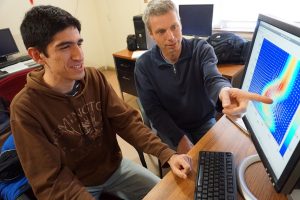By: Linda Fresques
 |
|
|
New Mexico State University aerospace engineering doctoral student Sergio Romero, left, and mechanical and aerospace Assistant Professor Andreas Gross are researching data obtained from computer simulations that may someday make jet aircraft lighter and less expensive to operate. (NMSU photo by Linda Fresques) JAN17 |
New Mexico State University Assistant Professor Andreas Gross has had a lifelong fascination with aircraft and gliders as well as wind turbines and sailboats. In his own words, “anything that has to do with fluid dynamics is of interest.”
His passion led to master’s and doctoral degrees in fluid dynamics (the study of gases and liquids in motion) from Stuttgart and Aachen University in his native Germany, as well as an active research portfolio in the field.
Gross is currently conducting research funded by the Air Force Office of Scientific Research on methods to make jet engines more powerful and lighter, ultimately rendering civilian and military air travel less expensive. This research is being conducted in collaboration with the U.S. Air Force Research Laboratory at Wright-Patterson Air Force Base in Ohio where Gross has spent several months for the past three summers working on the project.
“This is a part of the project that I really enjoy,” said Gross. “It’s really useful to meet other researchers and exchange ideas with them.”
The fan is the largest visible moving part of modern jet engines. It also provides most of the thrust. Thrust opposes drag and thus allows an aircraft to maintain its airspeed during cruise. The fan is driven by the low-pressure turbine. The low-pressure turbine consists of rows of blades that are extracting power from the air flow.
Researchers at Wright-Patterson are developing new highly loaded low-pressure turbine blade shapes that would allow for a reduction of the number of turbine blades that would make the engine lighter. These new blades are being tested in the wind tunnel at Wright-Patterson.
At NMSU, Gross is conducting computer simulations of the airflow over the blades. The simulations are carried out on large supercomputers at the Department of Defense High Performance Computing Modernization Project centers. The data obtained from the simulations is highly resolved in both time and space and allows the researchers to investigate the low-pressure turbine fluid dynamics in great detail.
“We are trying to understand where losses in efficiency occur and how to reduce them,” said Gross. “We hope to provide impetus for the design of new low-pressure turbine blades that will improve the fuel efficiency and performance of future jet engines.”
Gross shares his keen interest in the classroom and beyond. He is being assisted in this research by doctoral candidate Sergio Romero. He also serves as adviser to the NMSU Mechanical and Aerospace Engineering student chapter of the American Institute of Aeronautics and Astronautics and students involved in the organization’s Design, Build, Fly Competition. A licensed pilot, Gross is a member of the West Mesa Flying Club and the White Sands Soaring Association and encourages student participation in both organizations.
“Eye on Research” is provided by New Mexico State University. This week’s feature was written by Linda Fresques of the College of Engineering.
